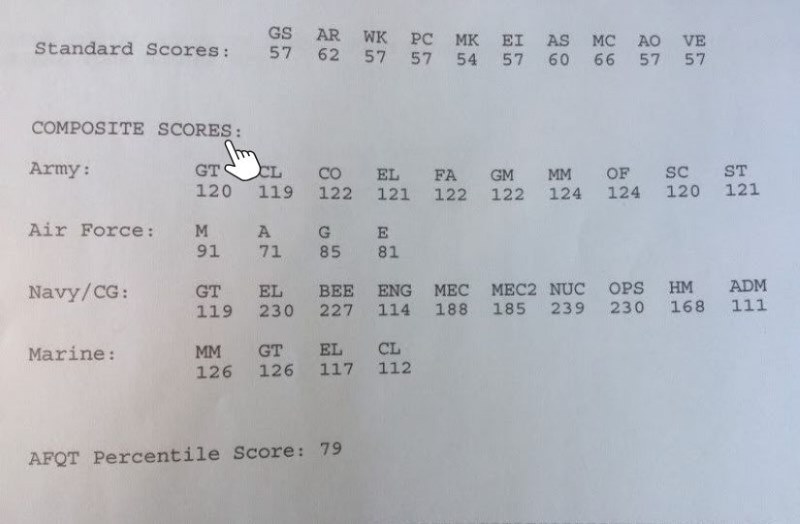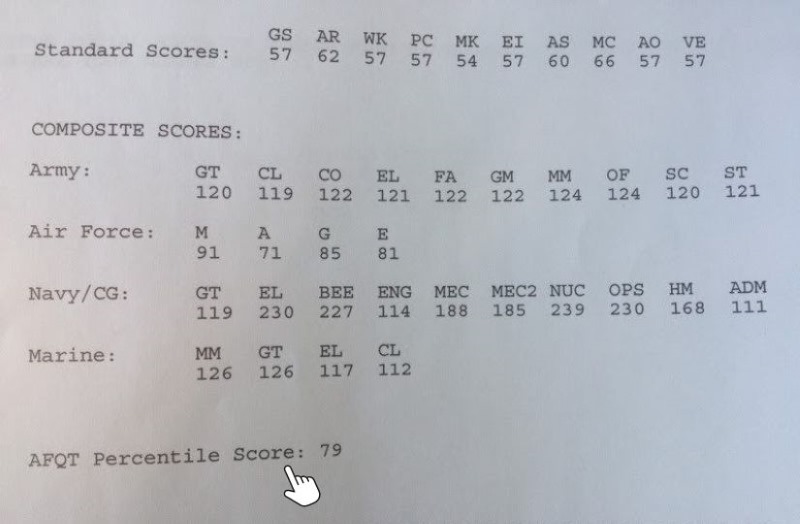We all know that ASVAB scores are extremely important for your military career and future opportunities. However, interpreting these scores can take a lot of work. You can be confused with a score sheet that includes so many confusing and complex scores. “What do these scores mean?”
Don’t worry. You’re in the right place. In this post, we provide you with clear instructions on how to read and interpret ASVAB scores, along with extremely useful advice to help you fully understand your scores. Let’s get started!
How to read ASVAB scores for military enlistees
After your scores are processed, you’ll receive a scorecard with various types of scores as illustrated below. To read the ASVAB scores effectively, follow these steps:
Step 1: Read ASVAB standard scores
At the top of your ASVAB scorecard, you’ll find your standard scores. These scores indicate how well you did on each subtest compared to the average test-taker. For example, if your standard score for Arithmetic Reasoning is 60, it means you performed better than 60% of the test-takers. This score helps assess your proficiency in solving arithmetic problems.

Step 2. Identify your ASVAB composite scores
Just below the standard scores, you’ll find your composite scores. These scores are aggregates of various subtest scores and are used to assess your suitability for specific military job roles.

Composite scores often include categories that are most important in different military branches. Look at your composite scores in the Army, Air Force, Navy, and Marine, then identify your most suitable role in the military. For example, a high score in the Mechanical Maintenance composite indicates strong performance in areas related to mechanical and technical skills, which may qualify you for specialized technical roles in the Army.
Step 3. Interpret your AFQT scores
The AFQT score is a key component of your ASVAB results. This score is located in a separate section and is used to determine your overall eligibility for military service. The AFQT score is derived from a combination of your scores in Arithmetic Reasoning, Mathematics Knowledge, Paragraph Comprehension, and Word Knowledge.

Step 4. Compare with branch requirements
Research the minimum AFQT and composite score requirements for the branch of the military you’re interested in to see if you qualify. Each branch has different standards. For example, the Army might require a minimum AFQT score of 31, while the Air Force may require a score of 36. If you’re aiming to join the Air Force and your AFQT score is 35, you’re close but might need to improve to meet the Air Force’s minimum requirement.
Advice on how to read the ASVAB scores
Reading your ASVAB scores can be complex and challenging. Here’s some advice to help you interpret your ASVAB scores effectively:
- Ask for guidance: If you find the ASVAB score report confusing, don’t hesitate to seek help. Reach out to your recruiter or school counselor for assistance. They can provide a detailed explanation of your scores and offer guidance on your career as well as military paths.
- Focus on key areas: When reviewing your ASVAB scores, concentrate on the areas that will have the most significant impact on your career and educational aspirations. For example, if you want to be enlisted in the Air Force, focus on your scores in the composite score section of the Air Force.

FAQs
1. Where can I find my ASVAB scores?
There are two ways for you to find your ASVAB scores: online and offline. Follow the detailed guidance on how to check the ASVAB score.
2. How to calculate ASVAB scores?
ASVAB scores are calculated based on your answers to the test questions. Here’s a simplified breakdown:
- Raw Scores: Calculate the number of correct answers for each subtest
- Standard Scores: Raw scores are converted to Standard Scores
- Composite Scores: Combine Standard Scores from related subtests to form Composite Scores
- AFQT Score: The score is derived from a subset of subtests and is used to determine overall eligibility for enlistment.
We’ve developed an ASVAB score calculator to help you compute your scores automatically and accurately. Check it out!
3. How can I improve my ASVAB scores?
Here are some simple steps for you to improve your scores:
- Understand the test structure
- Make a study plan
- Develop study strategies
- Practice with sample tests
- Have test-taking strategies
For more detailed guidance, follow our steps on How to score high in the ASVAB. Check it out and get started on your path to improve your ASVAB score!
4. What is the difference between AFQT and ASVAB?
The ASVAB is a comprehensive test that includes multiple subtests measuring various skills and knowledge areas, while the AFQT is a subset of the ASVAB and specifically assesses general cognitive abilities:
- ASVAB: Measures overall aptitude across different areas.
- AFQT: Focuses on arithmetic reasoning, mathematics knowledge, word knowledge, and paragraph comprehension to determine enlistment eligibility.
Read ASVAB vs AFQT to fully understand the differences between these two tests.
5. What is a good ASVAB score?
A “good” ASVAB score depends on your career goals and the requirements of the military branch you are interested in:
- Standard score: A score of 50 is typically considered average. Scores above 60 are often seen as competitive.
- Branch requirements: Different military branches have varying minimum score requirements. For example, the Army might require a minimum AFQT score of 31, while the Air Force often requires a higher score.
Final thought
Now you know how to read the ASVAB scores. Effectively interpreting your scores can provide valuable insights into your strengths, areas for improvement, and your potential in career positions. Whether you’re a high school student looking to use your scores for career exploration or a military enlistee preparing for your next steps, accurately reading your ASVAB scores is crucial for your future path.




